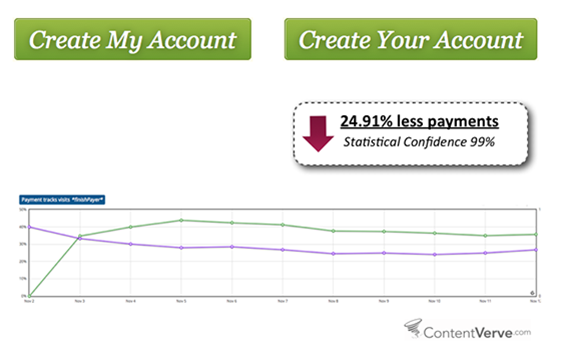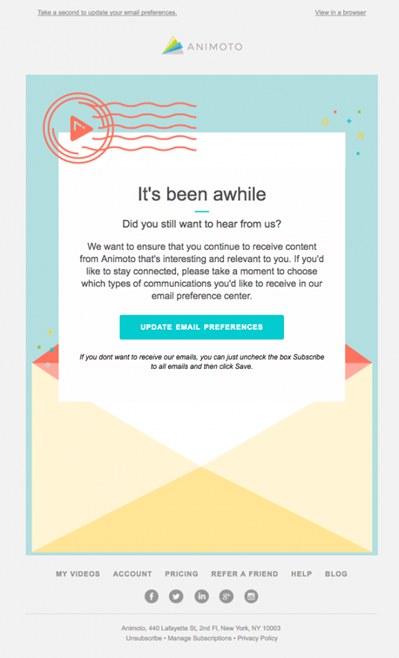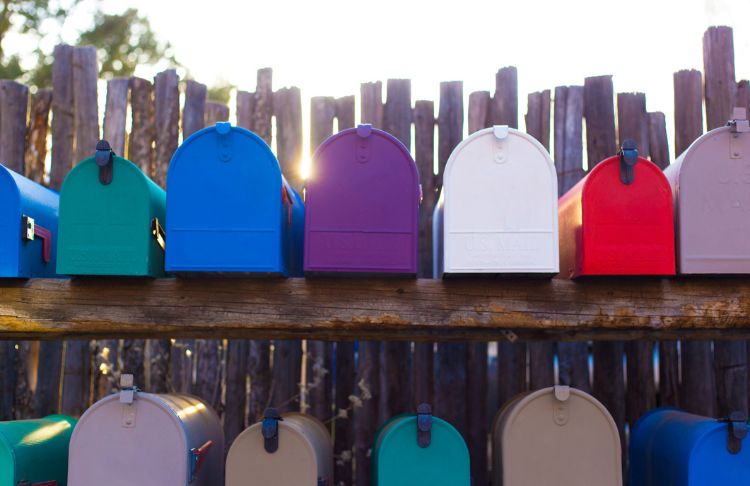An email is only as good as its copy. You can have the best images in the world, but without the right subject line, persuasive sentences, and a killer call-to-action, your email is going to flop.
That’s why email copywriting can be a mind-boggling task. You have to strike a balance between promotional, educational, persuasive, and benefit-focused—often in 125 words or less!

To make this daunting task a breeze for you, we came up with 14 actionable email copywriting tips and tricks to help you connect with your audience, increase open rates, and convert subscribers into customers.
So, let’s get started!
1. Start with the goal for your email
The first step to effective email copywriting is to understand the purpose of sending said email. You’ll want to create action-oriented emails that encourage the user to take the next step. What do you want the email subscribers to do after reading the email?
Do you want them to sign up for your free trial, purchase a product, follow you on social media, or download your mobile app?
Based on the action you want them to take, you can frame your email copywriting accordingly.

2. Know your audience and what will encourage them to take action
Before you begin writing copy for your email, it’s important to understand your audience. List segmentation can help you hone in on a specific audience and create emails that appeal to them. Try to create customer avatars for your target audience and then figure out what kind of email copy will be most impactful for them.
For example: If you offer products related to mother care, your target audience is probably expecting women or lactating mothers. You would likely want to create different emails for your audience that is expecting versus your audience of new moms currently lactating. By adjusting your email copywriting to the correct audience, you can increase the chance that your audience will open your email and take action.
Related: Try direct response copywriting tactics to drive actions from your emails.
3. Spend some time crafting your email subject lines
Your subject lines must be long enough to convey the purpose of the email but short enough to tap into the inquisitive instinct of your readers.

To make the subject line copy more interesting, you can use dynamic elements such as the user’s geographical location and past purchases along with the first name personalization. You can even use emojis in your subject lines to add a personal touch to your emails.
If you want to go a step further and make your subject line copy even more impactful, you can take the help of AI-driven tools like Phrasee that use predictive models and NLP (Natural Language Processing). Through such tools, you can create powerful subject lines that will help you to increase the open rate as well as the conversion rate.
4. Focus your email copywriting on the benefits, NOT the features
If you’re sending an email about a new product, it’s going to be quite tempting to mention all the technical features in your promotional emails, but you must hold yourself back. Instead, focus on the benefits of your product, service, or solution—that’s what your customers truly care about. And make sure not to include any jargon or acronyms that your customers wouldn’t easily understand as part of your email copywriting.
For instance, to promote WordPress development services, you should let your subscribers know how your services can help them create a high-converting WordPress website that will take their business to the next level. Do not get into the coding intricacies.

5. Use the second-person narrative in your email copywriting
Addressing your customers directly is another email copywriting trick that can help you get more opens and conversions. The second-person voice is much more conversational and approachable, so address the reader with “you.” This will make your email look as if it is drafted exclusively for the reader as it focuses on them directly. Adding a personal touch with second-person voice with your email copywriting will initiate a more intimate feel to seem as if you’re having a one-on-one conversation with each member of your audience.

6. Use the “write” words for your email copy
Email copywriting is all about using appropriate words that can persuade email subscribers to take action. Sift through the dictionary to find the most impactful word to convey your message or do a quick search for the best words to use in marketing copy. This will help your email stand out from the crowd and create an emotional connection with your reader.
For instance, if you own a travel agency looking to promoting vacation deals, you can use powerful words like picturesque, scenic, mesmerizing, splendid, and verdant rather than beautiful.
Check out 200+ more emotional words to use in your marketing copy here.
7. Be empathetic
Email marketing—especially automated email marketing—can often be cold and feel robotic or out of touch. That keeps people from opening your emails and taking action, so lead your email copywriting with empathy and make adjustments to your strategy as needed. You may need to revisit your automated emails every once in a while and optimize them to align with current events, holidays, or your marketing goals. If needed, you can even remove some of the automated emails from your list.
Take into account what your customers are experiencing and adjust your email copy accordingly.
Look at this considerate email by Waitrose & Partners through which they have allowed their subscribers to opt-out of Mother’s Day emails.

8. Take a storytelling approach with your email copywriting
Didn’t you love stories as a kid? Well, we still do, right? Besides entertaining the reader, stories appeal to your subscribers’ emotions. Another reason why you must use the power of storytelling in your email copywriting is that your readers are 22 times more likely to remember a story over simple facts.
Stories fit in quite well in welcome emails if you want to share the inception of your business, your mission statement, or your brand story. Furthermore, you can also feature your customer testimonials in the form of a success story.
9. Get to the point
A rule of thumb for email copywriting is to keep it short. Research shows that the best emails are 50 to 125 words, which means you have to pack a punch into each and every character in your email.
We’ll leave it at that!
10. Have a clear call-to-action (CTA)
Though your CTA is generally placed after the header image and body copy of your email, it plays the decisive role in whether your subscribers will convert or not. A well-designed email that has everything but an imperceptible CTA will barely bring any results. This is because without a clear CTA, people will be confused as to what they should actually do with the information you present in the email.
Your CTA must be drafted in a way that attracts the subscriber’s attention and prompts them to click on it.
Another trick to get more people to click-through is to write your CTA in the first-person voice. First-person CTAs help to yield about a 25% higher conversion rate from emails.

You can take your email copywriting game a step further by generating a sense of urgency for even more conversions. To illustrate, a CTA that says “Sign up today and avail 80% discount” will create a fear of missing out in the subscriber’s mind and get them to act instantly.
You can use phrases like “Hurry, offer valid till stocks last,” “50% off only for today,” “Only 5 items remaining.” and “Time is running out…” to encourage your subscribers to make the purchase.
11. Write your emails according to where your audience is in the buyer’s journey
Most marketers send out lead nurturing emails and sales emails to all their subscribers. This is not the correct way to go about it. One heavily used sales tool, the Chet Holmes Pyramid, can apply to your email demographics as well which can clue us in on which leads we should or should not be nurturing.

This implies that only 10% of the prospects are thinking about making a purchase. This also ties into the buyer’s journey. Before approaching any subscriber with a sales pitch, keep their buyer’s journey in mind. Suppose a user has just signed up for your emails. You might send out a welcome email, introducing your brand to them rather than the pricing structure or quotation because they’re still at the beginning of their buyer’s journey.
By adjusting your email copywriting to where your subscribers are in their buyer’s journey, you can create emails that appeal to them best and move them through the sales funnel.
Related: Find out the top types of emails you should be sending–and when!
12. Follow Dean Jackson’s theory for your re-engagement emails
When you’re looking to re-engage subscribers via email copywriting, you may want to incorporate another structure that has proven success. Marketing thought leader Dean Jackson supports the usage of a nine-word template to win back dormant leads. This theory worked wonders for a yacht broker to crack a high-ticket client. The concept refers to the usage of the phrase “Do you still want to…”
Let’s understand this theory with the help of some examples:
• Are you still looking for an apartment in Ontario?
• Do you still want to run LinkedIn ads?
• Are you still looking for flight tickets to Las Vegas?
Such phrases remind the inactive leads about their past interaction and increase the email engagement by triggering FOMO. This is an easy email copywriting trick that can be incorporated into some of your email marketing messages.

13. A/B test your email copywriting to find out what resonates best
There’s a huge difference in how your customers made purchasing decisions in 2020 (before the pandemic) versus in the post-pandemic year of 2021. What worked in 2019 or 2020 might not work anymore. Therefore, you must A/B test your emails and try to figure out what kind of email copy performs the best. That means you’ll want to have a couple of versions of your core email on hand to try out and then compare.
14. Monitor the performance of your email campaigns and make improvements to your email copy
Analyzing your email performance data matters more now than ever. Keep track of email metrics such as open rate, click-through rate, conversion rate, and unsubscribes. Based on these insights, keep optimizing your email copywriting to bring in the results you are looking for. This will also help you keep your email copy from getting stagnant. In fact, you should be consistently tweaking it according to your email marketing results. This will help to keep your email copy fresh to viewers while also keeping up with current email marketing trends.
Apply these email copywriting tips today for better email performance tomorrow
Email copywriting is not about using fancy and complicated language. If there’s one thing we can take away from all of these email copywriting tips, it’s that it’s all about crafting a message around your business’s goal and delivering what your customer is looking for. Think like the customer rather than a marketing professional—that’s the key to writing a high-converting email copy, or blog posts, or ebooks…






